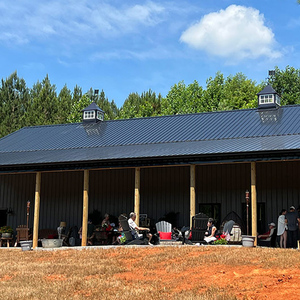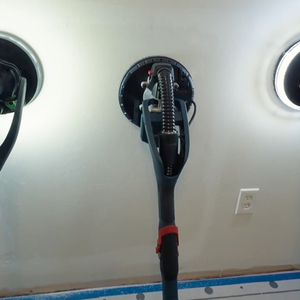*
I don’t know the “school solution,” but in my basement I put plastic on the wall from under the sole plate up to above the outside grade. Studded the wall and insulated with sheet foam. No interior vapor barrier. I’ve neither seen nor smelled any sign yet of moisture problems. Location is western Wisconsin, where summer basement temperatures will rarely exceed 65 F and rarely get below 55 F in the winter. I attribute the small temperature range at seasonal extremes to strategically placed duct leaks installed by my HVAC contractor.
Discussion Forum
Discussion Forum
Up Next
Video Shorts
Featured Story

There are important considerations to keep in mind when building a slab-on-grade home with continuous insulation.
Featured Video
Builder’s Advocate: An Interview With ViewrailRelated Stories
Highlights
"I have learned so much thanks to the searchable articles on the FHB website. I can confidently say that I expect to be a life-long subscriber." - M.K.
Fine Homebuilding Magazine
- Home Group
- Antique Trader
- Arts & Crafts Homes
- Bank Note Reporter
- Cabin Life
- Cuisine at Home
- Fine Gardening
- Fine Woodworking
- Green Building Advisor
- Garden Gate
- Horticulture
- Keep Craft Alive
- Log Home Living
- Military Trader/Vehicles
- Numismatic News
- Numismaster
- Old Cars Weekly
- Old House Journal
- Period Homes
- Popular Woodworking
- Script
- ShopNotes
- Sports Collectors Digest
- Threads
- Timber Home Living
- Traditional Building
- Woodsmith
- World Coin News
- Writer's Digest


















Replies
*
I don't know the "school solution," but in my basement I put plastic on the wall from under the sole plate up to above the outside grade. Studded the wall and insulated with sheet foam. No interior vapor barrier. I've neither seen nor smelled any sign yet of moisture problems. Location is western Wisconsin, where summer basement temperatures will rarely exceed 65 F and rarely get below 55 F in the winter. I attribute the small temperature range at seasonal extremes to strategically placed duct leaks installed by my HVAC contractor.
*
I'm going on the assumption that you live in a pretty cold climate....The problem you will have with your plan is that moisture will find it's way through or around your stud wall and condense on the surface of the poly you have applied to the face of the poured concrete wall. It will have the same effect as if you just had the bare wall.
This question was asked a couple of weeks ago. I always use 1 1/2" styrofoam glued directly to the concrete and seal the joints. I have not had any problem with condensation, but another fellow suggested also using a vapor barrier over the foam as extra insurance. This is fine if you feel more comfortable doing it this way, or you could use foil faced foam and seal it up with tape.
The point is....you want to eliminate that cold surface behind your stud wall, so you don't have a place for moisture to condense and cause problems. I don't use fiberglass in the walls. The foam seems to be adequate insulation and you don't wind up with a cold cavity between the stud wall and the poured wall.
*
I am finishing the basement of my second house and wonder about moisture and vapor barriers.
For my first house I used 2x4 stud walls, unfaced insulation, and 4 mil vapor barrier on the interior side (this appears to be recommend approach by mfgrs such as Owens-Corning). HOWEVER, on one wall (concrete block) that was 70% above ground on the outside, I had a problem in the summer. I noticed that condensation was forming on the cavity side of the vapor barrier. Obviously moisture laden air infiltrating in and condensing on the cooler (air-conditioned) interior. Wallboard was not installed, so I removed barrier and insulation, and was able to work a second 4-mil vapor barrier between studs and concrete block wall. This seemed to help.
My new project involves a poured concrete foundation (no block cavities), 90% below ground, in 4-year old construction. Wall has drain tile, gravel back fill, interior perimeter drains, sump pump etc, and I have no moisture problems.
Now for the question... What would be the problem with applying a 4-mil vapor barrier to the concrete wall, insulating a stud wall with kraft faced insulation, and finishing with drywall?
This in effect creates TWO vapor barriers (inner and outer). Might be overkill, but would it help create a dryer living space?
Concerns:
(1) Does the fiberglass insulation need to "breath"? If so, this is why I used 'kraft faced' on the inside which will be slightly leaky.
(2) Am I going to be trapping moisture
some where I don't want to...?
(3) Costwise, adding a 4-mil barrier is not much additional cose.
Any constructive comments or suggestions would be appreciated.
*
Up here in cold country we worry alot about vapor barriors.
I am a DYI but have read a lot. You try your best to install a bomb proof visqueen vaporbarrior, using Tremco and vaporbarrior tape to patch the plastic together.
But the concept is, IF any of your nice warm, humid inside air DOES get around the barrior and get into your insulation, then---- the resulting condensation has to keep going, over time, through the entire wall and eventually to the outside of the house.
Using 2 layers of visqueen is a NO NO!--- the moisture will just condense and get trapped on the second surface! Leading to mold, mildew----.
The rule is to make the exterior walls MORE permiable, as you go from the (warm) inside of the wall to the (cold) outside, to allow this renegade humid air to get all the way out!
Later,
Rick